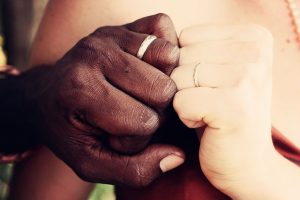 Will Meghan Markle be welcomed in the royal family? The recent wedding of Markle, a biracial woman of Black and White heritage, and Prince Harry, a White male member of the British royal family, marks a social milestone. More than fifty years out from the Supreme court decision that legalized interracial marriages across all 50 states in the U.S., this wedding has inspired a new conversation about racial inclusivity infusing “bicultural Blackness” within a traditionally white elite. The celebratory tone makes sense as mixed-race couples represent 17 percent of recently married couples in the United States. This increased demographic prominence also coincides with broad based approval. According to the Pew Research Center, 88 percent of millennials say they would be “fine with a family member’s marriage” to any racial group.
Will Meghan Markle be welcomed in the royal family? The recent wedding of Markle, a biracial woman of Black and White heritage, and Prince Harry, a White male member of the British royal family, marks a social milestone. More than fifty years out from the Supreme court decision that legalized interracial marriages across all 50 states in the U.S., this wedding has inspired a new conversation about racial inclusivity infusing “bicultural Blackness” within a traditionally white elite. The celebratory tone makes sense as mixed-race couples represent 17 percent of recently married couples in the United States. This increased demographic prominence also coincides with broad based approval. According to the Pew Research Center, 88 percent of millennials say they would be “fine with a family member’s marriage” to any racial group.
But is true acceptance solely being “fine” with a racially different in-law? While crossing racial lines has reached broad-based acceptance, do mixed-race families have access to the same supports from kin as their single-race peers? Families also routinely provide a range of vital resources, such as financial help, sharing residence, or child care.
The story on this front is considerably more complicated. A new short report, authored by myself and Ellen Whitehead and recently published in the Journal of Marriage and Family, reveals that White mothers of biracial infants are less likely than White mothers with White infants to report that they can rely on friends or family for help if needed. Interestingly, differences were not uncovered for either Black or Latina mothers.
How can interracial couples experience nearly universal acceptance and be more likely to perceive isolation from family resources? First, sociologists often note that approving of something in principle does not always translate into practice. This extends to interracial marriage, as sociologists Mary Campbell and Melissa Herman identify clear differences between Whites approval of interracial marriage and their likelihood of forming interracial relationships. Whites therefore may continue to hold, while not explicitly disclosing, negative attitudes toward interracial coupling.
Beyond, the broader context of race and class inequality needs to be more central to how we talk about and understand the dynamics of racial mixing. Differences in support between Whites with biracial and single race infants reveal the endurance of a white/non-white divide that can be found in nearly every social sphere – where we live, whom we call our friends, and where we go to school. How can interracial couples seamlessly traverse boundaries that remain intact?
In addition, race does not solely divide our associations, it also divides our access to resources, significantly influencing what families may be able to give. According to Pew, Blacks and Latinx families are more than twice as likely as Whites to be poor as of 2014. This broadly aligns with findings on absent resources. While a large share of White mothers of biracial infants reported having absent resources, their levels were quite close to perceptions reported by Black and Latina mothers, nearly 30 percent of whom report that family and friends could not help them in some way if needed. White women with white (single-race) infants were the most privileged, with only 10 percent reporting lack of support.
Experiences of interracial families lie at the nexus of race and class divides. While the expansion of mixed-race family formation signals the growing normalizing of interracial coupling, how families fare is more telling in how, or if, barriers are truly crossed.
Jenifer Bratter is a full professor of sociology at Rice University. She is a sociologist and demographer whose research explores racial mixing and its implications for unequal racial outcomes. She has recently published articles in Journal of Marriage and Family, Ethnicity and Health, Social Science Research, and Race and Social Problems. Email her at jbratter@rice.edu

Comments